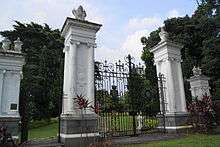Bidadari Cemetery
 The gate of the former cemetery, now located in a small memorial garden called Bidadari Garden at 10 Mount Vernon | |
 Location within Singapore | |
| Details | |
|---|---|
| Established | 1 January 1908 |
| Closed | 31 October 1972 |
| Location | Bidadari, Toa Payoh |
| Country | Singapore |
| Coordinates | Coordinates: 1°20′7.53″N 103°52′19.21″E / 1.3354250°N 103.8720028°E |
| Type | Historic, Municipal |
| Size | 26 hectares |
| No. of graves | 147,000 (Approx.) |
| Find a Grave | Bidadari Cemetery |
Bidadari Cemetery (Malay: Perkuburan Bidadari, Chinese: 比达达利坟场) is a defunct cemetery in Singapore. It used to serve the Christian, Muslim, Hindu and Sinhalese communities. The site of Bidadari Cemetery used to be the Istana residence of one of Sultan Abu Bakar of Johor's wives.[1]
History
The word bidadari means "fairy" in Malay, which was in turn derived from the Sanskrit word vidhya dhari, which means a nymph[2] of India's heaven or a houri of paradise. The bidadari are depicted as kindly fairies and genies that preside over the union of flowers.[3] In the local context, the name is a reference to the beauty of the Danish Zubaidah binti Abdullah (Cecilia Catharina Lange), second wife of then Maharaja of Johor Abu Bakar. She once had a house known as Istana Bidadari built there for her.
Istana Bidadari was also the birthplaces of Maharaja Abu Bakar and Zubaidah's daughter Tengku Mariam Al-Marhum, born on 21 December 1871, and their son, Ibrahim Al-Marhum, his successor, who was born on 17 September 1873.
Soon after Abu Bakar became Sultan of Johor in 1885, Sultana Zubaidah moved to Johor. The Istana Bidadari itself was left vacant until its demolition in 1915.
In 1902, the Municipal Commissioners officially declared the acquisition of 26 hectares of the property to be used as a cemetery, which would be named after the Istana Bidadari. The Bidadari Cemetery was officially opened on 1 January 1908.
There were several sections in the cemetery: The Christian section was across Upper Aljunied Road from the Muslim section, and was bounded by Upper Serangoon Road; the Muslim section (opened on 14 February 1910) was at the base of Mount Vernon, bounded by Upper Aljunied Road, Upper Serangoon Road, and Bartley Road; while the Hindu and Sinhalese sections were opened in 1929.
Part of the land was acquired by Syed Shaik Abdulrahman Alkaff of the prominent Singaporean-Arab Alkaff family. He built the Alkaff Gardens, which were styled as a Japanese landscaped garden with moats, typical Japanese wooden bridges and a teahouse. It was opened to the public in 1929 and was the first Japanese garden in Singapore. During World War II the land was requisitioned by the British army and then used by the Singapore Volunteer Field Ambulance Corps. After the war, it was developed into the Sennet Estate, and today the Cedar Girls' Secondary School stands on part of the site.[4] The Bidadari housing development project will incorporate a new Alkaff Lake in recognition of this heritage.[5]
Apart from being a place of remembrance, the trails inside Bidadari Cemetery used to be very popular as a running route for members of the Gurkha Contingent.
Notable burials
Bidadari once had sections for Hindus, Muslims and Christians and many prominent people were buried here.[6][7]
- Ahmad bin Ibrahim – Minister of Health and Minister of Labour
- Regent Alfred John Bidwell – British architect who designed the Raffles Hotel
- Douglas Campbell – British advisor in Johor
- Dr Lim Boon Keng – physician, writer, intellectual, and social reformer
- Mrs Grace Yin – 2nd wife of Dr Lim Boon Keng
- Sir Song Ong Siang
- Mrs Joan Giles – wife of Carl Giles
- Mr Bernard Giles
- John Laycock
- Sir George Edward Noel Oehlers
- Syarif Masahor – Sarawakian warrior
- Augustine Podmore Williams – English sailor, on whose life Joseph Conrad based his novel Lord Jim.
- Sir Duncan George Stewart – Second Governor of Crown Colony of Sarawak
- L/Cpl Thomas (Big Tam) Darling – The Queen's Own Cameron Highlanders and LT Malaya Police
- Gertrude Bryde Hodge (1939) – founder of Malaysian Girl Guide movement
- Baharuddin Ariff – People's Action Party assemblyman from 1959 to 1961
The Bidadari Christian Cemetery accepted military burials from 1907 to 1941, including Christian soldiers killed during the 1915 sepoy mutiny. In 1957, the Christian soldiers buried there were reinterred at Ulu Pandan War Cemetery and later moved to Kranji War Cemetery.[8]
The last burial at Bidadari Cemetery took place on 31 October 1972.
Exhumation and redevelopment
The area was earmarked for development in the government's 1998 land-use masterplan. Between 2001 and 2006, all known graves were exhumed and a memorial park was created at Mount Vernon to display the tombstones from prominent persons' graves. The Woodleigh MRT Station occupies part of the former site.[1] In late 2011, the Ministry of National Development (MND), developed a blueprint for a new housing estate with HDB flats and private housing. Works began in 2012, with the first batch of built-to-order HDB flats expected to be ready in 2018.
See also
References
- 1 2 Bidadari Cemetery, Singapore Infopedia.
- ↑ Goh, Si Guim. "Twilight for Bidadari". Retrieved 16 February 2015.
- ↑ Savage, Victor R.; Yeoh, Brenda (2013). Singapore Street Names: A Study of Toponymics. Marshall Cavendish Editions.
- ↑ "Alkaff Lake Gardens".
- ↑ "New Alkaff lake for Bidadari estate".
- ↑ Yeo, Nick. "Bidadari Cemetery". Retrieved 16 February 2015.
- ↑ "Bidadari Memorial Garden". National Heritage Board. Archived from the original on 25 November 2015. Retrieved 25 November 2015.
- ↑ "Bidadari Cemetery".
Bibliography
- Victor R Savage, Brenda S A Yeoh (2004), Toponymics – A Study of Singapore Street Names, Eastern University Press, ISBN 981-210-364-3.
| Wikimedia Commons has media related to Bidadari Garden. |
1972